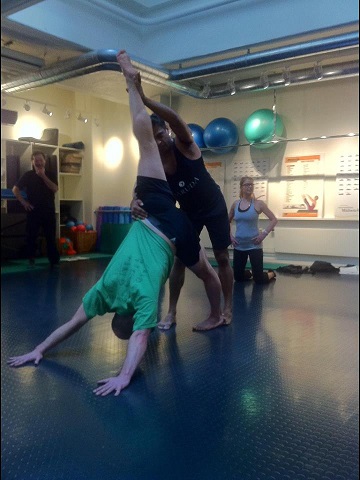 James D’Silva is the creator of the Garuda Method of exercise. The Garuda is known in Indian mythology to be a large sacred bird that changes its form according to its function. With a thriving studio based in London former dancer James D’Silva found ‘Garuda’ to be a fitting name for his system that he says is unique in its versatility, flexibility, flow and precision of movement. Throughout his career Pilates was an integral part of his training routine, along with yoga, GYROTONIC®, Feldenkrais and the Alexander Technique. James claims that Garuda offers a cardiovascular workout while teaching relaxation in movement, resulting in greater strength, posture and ease of movement, a focused mind and a compassionate, non-judgmental spirit.
James D’Silva is the creator of the Garuda Method of exercise. The Garuda is known in Indian mythology to be a large sacred bird that changes its form according to its function. With a thriving studio based in London former dancer James D’Silva found ‘Garuda’ to be a fitting name for his system that he says is unique in its versatility, flexibility, flow and precision of movement. Throughout his career Pilates was an integral part of his training routine, along with yoga, GYROTONIC®, Feldenkrais and the Alexander Technique. James claims that Garuda offers a cardiovascular workout while teaching relaxation in movement, resulting in greater strength, posture and ease of movement, a focused mind and a compassionate, non-judgmental spirit.
 James likes to say that where Pilates ends, Garuda begins.
James likes to say that where Pilates ends, Garuda begins.
Zoinkers! Is this all really true?
I am a trained Garuda matwork teacher with a well-attended weekly class. I have never been to James’ London studio, but trained with him in Stockholm three years ago, inspired by the organic beauty of the flowing movement.
I got a chance to chat with James, even though he was slightly irritated with me for not attending his classes during a recent Stockholm visit. But I know he loves me anyway so don’t take it too harshly, and we get right down to business. “James, just what do you mean with ‘where Pilates ends, Garuda begins?”
He answers with a calm confidence of a person who has enquired into the matter for a long time.
“The concept of movement is approached differently, my own Pilates training was very linear, and there were no spirals and few extensions. I find Pilates is not functional enough and there is too little work while standing and kneeling. I love the spring resistance of the reformer, but it does not prepare the student to be functional.
“In Garuda we constantly work with spirals, encouraging a dialogue between the spine and the extremities, and back to the spine. This I find completely missing in Pilates. Also, Pilates is limited in flow where movements are linked. There tends to be a lot of stopping for corrections disrupting the body’s own rhythm and freedom of innate intelligence. Interrupting this rhythm prevents the discovery of the natural alignment which can only occur in movement.”
Okay, that is certainly a point of view which one can argue with, and at times James and I do. But whatever your thoughts, I find James to be a worthwhile teacher, having personally seen that James inspires many people. I ask him why he is loved by hundreds of people worldwide.
 “Three aspects are important to the whole Garuda system, attention, intention and constant enquiry into the work. I always start a class bringing the type and quality of breathing into focus and end with a small meditation. This contributes to a constant play and change to the body’s rhythm that people find challenging and exciting. There is much talk of a mind-body-spirit dynamic in Pilates, but I think that the spiritual connection only occurs when there is space created in the body where a poignant nuance of sanctity resides. Moving naturally and according to the body’s rhythm can bring this about, and there is a lovely release of energy and sense of growth. Garuda is unique because encourages this process, awakening forgotten areas. I believe it is this that many find inspirational. “
“Three aspects are important to the whole Garuda system, attention, intention and constant enquiry into the work. I always start a class bringing the type and quality of breathing into focus and end with a small meditation. This contributes to a constant play and change to the body’s rhythm that people find challenging and exciting. There is much talk of a mind-body-spirit dynamic in Pilates, but I think that the spiritual connection only occurs when there is space created in the body where a poignant nuance of sanctity resides. Moving naturally and according to the body’s rhythm can bring this about, and there is a lovely release of energy and sense of growth. Garuda is unique because encourages this process, awakening forgotten areas. I believe it is this that many find inspirational. “
James expresses his love for teaching, “having the chance to convey this depth is wonderful for me-I love my work, and I love people. The moment someone comes in front of me and wants to learn, I cannot hold back, it is like in an instant and total love. They have made the effort to be there, I have to give.”
I bring balance to our interaction as the eternal sceptic – “Yes, but James, admittedly, the conveyance of this depth you talk about requires tremendous sensitivity and talent, certainly there are only a very few with the gift to teach your method.”
“Absolutely, when I train teachers, it is not about just moves and positions, but about learning to be sensitive. That takes time, and it takes practice. I tell my teachers, when you teach class, say what you are feeling, because this is the only way you can actually educate your client.”
 James is eager to point out that more important than Garuda is Mukti (Sanskrit word meaning ‘born free’), his ongoing project in India which includes the development of three orphanages and an elderly home. Mukti provides health, education and a safe haven to street children and orphans. In cooperation with an HIV and AIDS hospice. Mukti contributes to a healthier and safer environment for infected children, while homeless elderly are given care at Sister Lucy’s center in Pune. Mukti is James’ labour of love for which he not only raises money but also gives much personal time on site. James says “Seva (service) is an important part of self-development. One can be too caught up in one’s own existence and pettiness. Garuda is not only about,’the body beautiful’, it’s also about compassion and giving to yourself and others. At the Garuda studio in London there is a saying ‘Garuda is for Life’. We demonstrate our caring through our actions, words and thoughts…we want to make a change in our environment.” says James.
James is eager to point out that more important than Garuda is Mukti (Sanskrit word meaning ‘born free’), his ongoing project in India which includes the development of three orphanages and an elderly home. Mukti provides health, education and a safe haven to street children and orphans. In cooperation with an HIV and AIDS hospice. Mukti contributes to a healthier and safer environment for infected children, while homeless elderly are given care at Sister Lucy’s center in Pune. Mukti is James’ labour of love for which he not only raises money but also gives much personal time on site. James says “Seva (service) is an important part of self-development. One can be too caught up in one’s own existence and pettiness. Garuda is not only about,’the body beautiful’, it’s also about compassion and giving to yourself and others. At the Garuda studio in London there is a saying ‘Garuda is for Life’. We demonstrate our caring through our actions, words and thoughts…we want to make a change in our environment.” says James.
 I am still a hard core Pilates guy, and find the linearity that James speaks of to be essential in the development of body control. I am not terribly drawn to the more spiritual aspects of Garuda, and I have not witnessed a ‘spirit more compassionate’ in myself nor in others who study it regularly. But I find Garuda has great value, and when done well, it does facilitate the discovery of areas unknown. I also admire James’ tireless commitment to his students.
I am still a hard core Pilates guy, and find the linearity that James speaks of to be essential in the development of body control. I am not terribly drawn to the more spiritual aspects of Garuda, and I have not witnessed a ‘spirit more compassionate’ in myself nor in others who study it regularly. But I find Garuda has great value, and when done well, it does facilitate the discovery of areas unknown. I also admire James’ tireless commitment to his students.
So Pilates lover, if an opportunity arises to experience James’ work, I can warmly recommend a try. He will love you, and help to open aspects of your being of which you were not aware.
If you want to learn a more about James, checkout his website.
